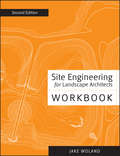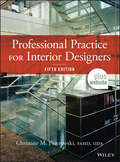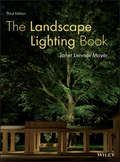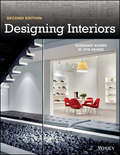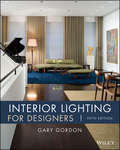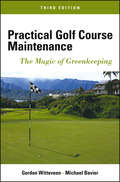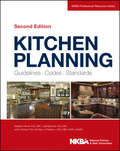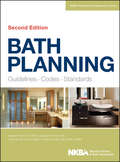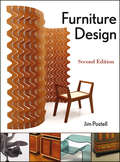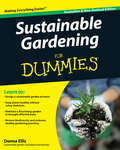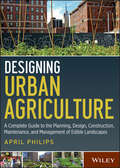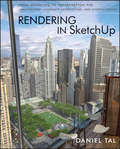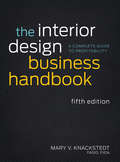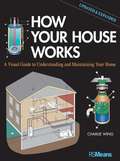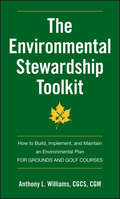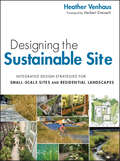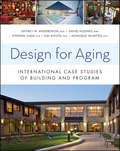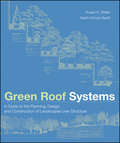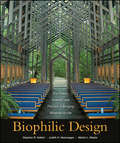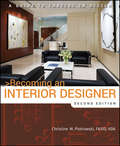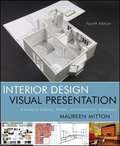- Table View
- List View
Site Engineering Workbook
by Jake WolandA study guide to help you master the principles and practices of site engineeringWhether used in conjunction with the Sixth Edition of Site Engineering for Landscape Architects or on its own, this Workbook is an invaluable learning resource for students and instructors, as well as for professionals studying for the LARE and other licensing exams.Organized into chapters that correspond with those in the textbook, the Workbook offers:Practice questions, problems, and review exercises designed to reinforce site engineering conceptsSite and grading diagrams that make it possible to apply site engineering concepts in a practical wayFour types of questions-observations, short answer, long answer, and graphic exercises-that offer opportunities to approach the material from varied angles and levels of complexityAnswers to workbook problems, provided online via an instructor's siteDesigned for the needs of both students and professionals, this Workbook makes it easier than ever for you to quickly master the principles and practices involved in today's environmentally sound site engineering.
Professional Practice for Interior Designers
by Christine M. PiotrowskiThis updated edition of the most comprehensive business guide for designers covers the interior design profession in a clear and well-organized style. From establishing a practice to managing a project, the reader progresses through all aspects of the business, whether in a small or large firm. The new edition includes additional information on ethics, as well as a companion website containing sample forms and other resources. This book is recommended by the NCIDQ as preparation for their professional registration examination.
The Landscape Lighting Book
by Janet Lennox MoyerThis richly illustrated, up-to-date guide offers practical coverage of all aspects of lighting design. Written by an award-winning, internationally known lighting designer, it covers lighting practices, materials, and their design applications and offers guidelines for preparing lighting drawings, control and transfer charts, symbol lists, and other technical specifications. This edition provides a new focus on the use of LEDs, as well as new and expanded coverage of renderings, Mesopic Vision, and the latest controls approaches and systems.
Designing Interiors
by W. Otie Kilmer Rosemary KilmerAfter its publication in 1992, Designing Interiors became a hugely successful reference tool and designing textbook. In Designing Interiors, Second Edition, updates on trends in sustainability and green design, building codes, universal design, and building information models amplify the already invaluable interior design tricks of trade. Design professors Rosemary and Otie Kilmer provide a fuller design history that incorporates non-Western design and dynamic color illustrations that flesh out technical concepts.
Landscape Architecture Documentation Standards: Principles, Guidelines And Best Practices
by Design WorkshopAchieve better execution with the documentation standards behind an industry-leading firm Construction Documentation Standards and Best Practices for Landscape Architectural Design offers guidelines, methods, and techniques for creating more robust project documents. Developed and authored by one of the world's leading landscape architectural firms, this material has been field tested by Design Workshop's ten offices and 150 designers to ensure completeness, practicality, and effectiveness. The book provides an overview of the entire design and construction process in the context of actual documentation, with best practice standards for design document content, format, and graphics. Readers learn how to apply these practices to serve the specific needs of different projects, gaining a comprehensive understanding of how complete documentation better serves the project as a whole. Good documentation leads to good execution, which leads to better performance from the perspectives of durability, safety, and user enjoyment. This book presents a set of standards that serve as a roadmap of the design process, helping designers provide the complete documentation that the most highly executed projects require. Discover how documentation ties into project performance Learn the best practices for documenting every stage of the process Study actual project documents serving various project needs Gain documentation insights from one of the world's top firms Design Workshop has been an industry leader since 1969, with projects ranging from resorts, to wildlife refuges, to county master plans. The value of their insight is proven by the continued high performance of their projects across the U. S. and beyond, and this book contains the standards, techniques, and actual documentation behind this success. Better outcomes require better execution, which starts with the documentation standards presented in Construction Documentation Standards and Best Practices for Landscape Architectural Design.
Interior Lighting for Designers
by Gary GordonThis revised edition of the successful primer thoroughly covers fundamentals of lighting design, and also serves as a handy reference for professional designers. The Fifth Edition is more comprehensive than ever, with new information on LED, energy efficiency, and other current issues. In addition, it includes more information for drawing ceiling floor plans and the application of designs to specific types of interiors projects. Considered a "key reference" for the Lighting Certified exam, no other text combines both technical and creative aspects of lighting design for beginners and novice designers.
Practical Golf Course Maintenance
by Michael Bavier Gordon WitteveenThe revised, bestselling resource of practical, nontechnical advice for maintaining and operating a golf coursePractical Golf Course Maintenance, Third Edition presents the latest information and techniques for providing first-rate upkeep and management operations for any golf course. This book's, clear, step-by-step coverage, unencumbered by technical language, includes critical advice on maintaining consistent bunkers, sand top-dressing and aerifying, pesticide storage, and other emerging technologies, as well as mowing techniques for greens, fairways, and tees-and much more!This updated Third Edition offers reliable, state-of-the-art guidance and hundreds of helpful tips with:Major revisions throughout to address the latest information on computer- operated irrigation systems, new equipment for all aspects of course maintenance, water quality and conservation issues, and managing peopleA clear approach that avoids technical language and scientific citations while delivering practical advice that can be immediately applied on the courseCoverage of all aspects of course maintenance from tee to green, along with guidance on managing the course for the rules of the game and managing the business aspects of course management and maintenancePractical Golf Course Maintenance, Third Edition is a valuable tool for golf course owners, architects, builders, golfers, golf professionals, club managers, and superintendents, as well as greens committee members, irrigation specialists, field managers, turfgrass specialists, real estate developers, and landscape architects.
Kitchen Planning
by NkbaThe leading resource for student and professional kitchen designers-completely revised and updatedKitchen Planning is an essential reference for any designer working in the kitchen field, containing everything a professional needs to know to design kitchens that are convenient, functional, and efficient, and that meet the needs of today's lifestyles. Based on the National Kitchen and Bath Association's Kitchen and Bathroom Planning Guidelines and the related Access Standards, this book presents the best practices developed by the Association's committee of professionals through extensive research.This Second Edition has been completely revised and redesigned throughout, with new full-color photographs and illustrations and a special emphasis on client needs, research, and references to industry information. Features include:New and expanded information on universal design and sustainable designThe 2012 edition of the NKBA Planning Guidelines with Access Standards and up-to-date applications of the 2012 International Residential Code®New information about storage, cabinet construction, and specifying cabinetsMetric measurement equivalents included throughoutA companion website with forms and teaching resources for instructors
Bath Planning: Guidelines, Codes, Standards (NKBA Professional Resource Library #2)
by NKBA (National Kitchen and Bath Association)The leading resource for student and professional bath designers—completely revised and updated Bath Planning is the most authoritative resource available on the subject, containing everything a professional needs to know to design a safe, functional, effective, and attractive bath. Based on the National Kitchen and Bath Association's Kitchen and Bathroom Planning Guidelines and the related Access Standards, this book presents the best practices developed by the Association's committee of professionals through extensive research. This Second Edition has been completely revised and redesigned throughout, with new full-color photographs and illustrations and a special emphasis on client needs, research, and references to industry information. Features include: New and expanded information on universal design and sustainable design The 2012 edition of the NKBA Planning Guidelines with Access Standards and up-to-date applications of the 2012 International Residential Code New information about storage, cabinet construction, and specifying cabinets Metric measurement equivalents included throughout A companion website with forms and teaching resources for instructors
Furniture Design
by Jim PostellThe comprehensive guide to furniture design— expanded and updated Furniture designers draw on a range of knowledge and disciplines to create their work. From history to theory to technology, Furniture Design offers a comprehensive survey of the essential craft- and practice-related aspects of furniture design. Generously illustrated with photographs and drawings—including a new color section—this Second Edition features updated coverage of material specifications, green design, digital design, and fabrication technologies. It also features twenty-five case studies of furniture design that represent a broad selection of works, designers, and techniques, including recent designs produced within the last decade. The book explores: Furniture function and social use Form, spatial organization, and typological orders Structural integrity and composition Accessibility, universal design, human factors, and ergonomics The design process, from schematics through fabrication Materials, processes, and methods of fabrication Professional practice and marketing The history of furniture design, from prehistory to the digital age Complete with a glossary of terms and a comprehensive bibliography, Furniture Design, Second Edition is a one-stop resource that furniture designers will turn to regularly for the advice, guidance, and information needed to perform their craft.
Sustainable Gardening For Dummies (For Dummies Ser.)
by Donna EllisCreated especially for the Australian customer! Reduce your environmental footprint in the garden with this practical guide With all the talk about the health of the planet, you've probably heard about sustainability. Now you can apply these principles in your own backyard, whether that's an Aussie apartment balcony or a sprawling Kiwi rural spread. Find out great techniques for planning your sustainable garden and keeping your plants - and you - happy and healthy. Plant nutrients - what are they and how can you supply them to your plants sustainably? Watering techniques - how much water does your garden really need, and how can you conserve and supply it? Landscaping and gardening materials - where do they come from and are they sustainable? Biodiversity - how do you help increase the biodiversity of the planet through your own gardening practices? Organic gardening, permaculture and biodynamics - what methods can you adopt to improve your sustainable garden? Weeds and pests - how are they defined, and how do you control them while being kind to the environment? Compost heaps and worm farms - how do you build and maintain them, and what do they do for your garden? Potting mix - how can you choose a sustainable product or even make your own?
Designing Urban Agriculture
by April PhilipsA comprehensive overview of edible landscapes-complete with more than 300 full-color photos and illustrations Designing Urban Agriculture is about the intersection of ecology, design, and community. Showcasing projects and designers from around the world who are forging new paths to the sustainable city through urban agriculture landscapes, it creates a dialogue on the ways to invite food back into the city and pave a path to healthier communities and environments. This full-color guide begins with a foundation of ecological principles and the idea that the food shed is part of a city's urban systems network. It outlines a design process based on systems thinking and developed for a lifecycle or regenerative-based approach. It also presents strategies, tools, and guidelines that enable informed decisions on planning, designing, budgeting, constructing, maintaining, marketing, and increasing the sustainability of this re-invented cityscape. Case studies demonstrate the environmental, economic, and social value of these landscapes and reveal paths to a greener and healthier urban environment. This unique and indispensable guide: Details how to plan, design, fund, construct, and leverage the sustainability aspects of the edible landscape typology Covers over a dozen typologies including community gardens, urban farms, edible estates, green roofs and vertical walls, edible school yards, seed to table, food landscapes within parks, plazas, streetscapes and green infrastructure systems and more Explains how to design regenerative edible landscapes that benefit both community and ecology and explores the connections between food, policy, and planning that promote viable food shed systems for more resilient communities Examines the integration of management, maintenance, and operations issues Reveals how to create a business model enterprise that addresses a lifecycle approach
Rendering in SketchUp
by Daniel TalThe sure way for design professionals to learn SketchUp modeling and rendering techniquesRendering In SketchUp provides instructions for creating 3D photoreal graphics for SketchUp models using integrated rendering programs. The book serves as a beginner rendering manual and reference guide to further develop rendering skills. With an emphasis on step-by-step process, SketchUp users learn a universal approach to rendering varied SketchUp projects, including architecture, interiors, and site design models.The book focuses on tasks and principles at the core of photorealistic rendering, including:Rendering process: Learn a step-by-step process focused on workflow within SketchUp's familiar workspace. Universal method: Understand how the process can be used to work with a variety of different integrated rendering programs, including Shaderlight, SU Podium and Twilight Render**. These programs are easy to learn and function in SketchUp. >Textures and materials: Discover how to obtain, apply and edit texture images representing surfaces. Component details: Learn how to acquire and organize model details to allow for rich, expressive settings while maintaining computer and SketchUp performance. Exterior and simulated lighting: Learn to set exterior lighting with the SketchUp's Shadow menu or illuminate a scene with simulated lights, lamps, and bulbs. Render settings: Use specific settings for various rendering programs to quickly set texture character, image quality, and graphic output. Computer specifications: Find out how computers produce renders and the type of computer hardware required to streamline the process. Photoshop post-processing: Learn how to further refine rendered images in Photoshop. **Free online chapters: The book reviews specific settings for SketchUp and the rendering plug-in Shaderlight. Given the ever-changing nature of technology, free, online accompanying chapters detail settings for additional integrated rendering programs including SU Podium, Twilight Render, and more.
The Interior Design Business Handbook: A Complete Guide to Profitability
by Mary V. KnackstedtThousands of interior design professionals have come to rely on The Interior Design Business Handbook for comprehensive, accessible coverage of the essential procedures, tools, and techniques necessary to manage a successful interior design business. The Fifth Edition of this essential resource has been revised to address the latest trends and changes in the field, with new and updated material on business size and structure, building a brand, client development, social networking and Internet marketing, finances, purchasing, technology and software programs, and other key areas. Complete with more than 75 sample forms and letters, this Fifth Edition is a one-stop resource for all aspects of establishing and running an interior design business—from choosing a location and managing day-to-day operations to growing a business and putting it up for sale. All of the techniques and procedures in the book are rooted in real-world experience and are used daily in successful design firms throughout the United States. Filled with valuable information for solo practices and small firms as well as larger businesses, this book is an indispensable resource for seasoned professionals as well as interior designers who are at the start of their career.
Lighting Design Basics
by Mark Karlen James R. Benya Christina SpanglerThe essential book of lighting for professional designers, now updated and revisedProviding the fundamental information new designers need to succeed in a concise, highly visual format, the Second Edition of Lighting Design Basics presents realistic goals that can be used as a guide to create simple yet impressive lighting designs and when collaborating with professional designers on more complex projects.Drawing on real-world case studies-- from kitchens to doctors' offices--the book is packed with attractive, helpful illustrations, making it an invaluable resource for students, as well as interior designers and architects studying for professional licensing exams.Authored by leading lighting designers with decades of experience Offers straightforward coverage of lighting concepts and techniques Contains design scenarios for more than twenty different types of spaces Lighting is a basic, yet difficult-to-master element of interior design. Lightning Design Basics changes that, putting the power to create in the hands of the designer.
How Your House Works: A Visual Guide to Understanding and Maintaining Your Home
by Charlie WingUnderstand how to maintain everything in your home--including the kitchen sinkHow Your House Works, Second Edition reinforces the fact that it pays to be an informed consumer. Knowledge of your home's systems helps you control repair and construction costs and makes sure the correct elements are being installed or replaced. How Your House Works uncovers the mysteries behind just about every major appliance and building element in your house. Clear, full-color drawings show you exactly how these things should be put together and how they function, including what to check if they don't work.Covering topics such as electrical systems, heating and air conditioning, plumbing, major household appliances, foundation, framing, doors, and windows, this updated Second Edition has considerable additional information, with new chapters related to sustainability in and outside the house, as well as new topics, including clock thermostats, ventless gas heaters, moisture and mold, and passive solar heating.Illustrated guidance on electrical systems, heating and air conditioning, plumbing, major household appliances, foundation, framing, doors, and windowsIncludes a wealth of additional information, with new chapters related to sustainability and outside the houseFeatures new topics that include clock thermostats, ventless gas heaters, moisture and mold, LED lamps, motion-activated light switches, and passive solar heatingPresented in a richly illustrated with full-color drawingsWith see-through, cross-section drawings that show you how things are put together and how they function, How Your House Works supplies you with the knowledge that just might save you having to call in a professional.
The Environmental Stewardship Toolkit
by Anthony L. WilliamsA comprehensive, one-stop guide to environmental stewardship for golf courses and grounds This highly practical guide covers the full complement of tools green industry professionals need to create a successful environmental program on golf courses and grounds. Written by a leading golf course superintendent and grounds manager, The Environmental Stewardship Toolkit offers a comprehensive analysis of all relevant issues, including environmental management, resource management, community engagement, and document management. The emphasis throughout is on the development of programs that are both sustainable and practical, combining the protection and renewal of environmental systems with a workable business plan. Regulatory issues as well as concerns of owners, customers, and the community at large are also addressed. Clear, pragmatic, up-to-the-minute coverage includes: Numerous illustrations, photos, and customizable templates and checklists that readers can use in their own projects A system for sorting projects into green, greener, and greenest in order to tailor implementation for different budgets and project complexity An in-depth look at site assessment, water quality and conservation, integrated pest management, and wildlife habitat management Guidance for developing green public relations and communications skills to promote the project in the community Field-tested procedures for building a state-of-the art documentation system for capturing, organizing, and disseminating information A must-read for golf course superintendents, irrigation specialists, turfgrass specialists, and grounds managers, The Environmental Stewardship Toolkit is also useful for landscape architects and designers, grounds owners, developers, builders, contractors, and anyone wishing to be on the cutting edge of sustainability in the green industry.
Designing the Sustainable Site
by Heather VenhausThe full-color, practical guide to designing sustainable residential landscapes and small-scale sites "Going green" is no longer a choice; it's a necessity. Developed landscapes have played a significant role in exacerbating the environmental and social problems that threaten humanity; however, they can also be part of the solution. Designing the Sustainable Site: Integrated Design Strategies for Small-Scale Sites and Residential Landscapes gives site designers and landscape architects the tools and information they need to become a driving force in the quest for sustainability. Advocating a regenerative design approach in which built landscapes sustain and restore vital ecological functions, this book guides readers through a design process for new and redeveloped sites that not only minimizes damage to the environment but also actively helps to repair it. Designing the Sustainable Site: Assists designers in identifying and incorporating sustainable practices that have the greatest positive impact on both the project and the surrounding community, within a regional context Uses photographs, sketches, and case studies to provide a comprehensive look at successful green landscape design Illustrates how sustainable practices are relevant and applicable to projects of any size or budget Demonstrates how built environments can protect and restore ecosystem services Explains the multiple and far-reaching benefits that sustainable design solutions can provide Assists project teams in fulfilling credit requirements of green building assessment tools, such as LEED, BREEAM, or SITES With attention to six global environmental challenges-including air pollution, urban flooding and water pollution, water shortages, invasive species, and loss of biodiversity-along with guidance on how to meet these challenges, Designing the Sustainable Site is a practical design manual for sustainable alternatives to small-scale site and residential landscape design.
Design for Aging
by David Hughes Jeffrey Anderzhon Faia Riba Stephen Judd Emi Kiyota Monique Wintjies B. O. T.Architecture/Interior Design An in-depth look at the most innovative aged care facilities today With the world's population aging at a rapid pace, there is a growing need for new ways to provide residential care for older people. Design for Aging explores some of the most successful examples of elderly housing today, focusing on integrating architectural considerations within an unwavering people-driven approach. Written by an international team of experts in aged care design, the book brings together twenty-six case studies from around the world, including Australia, Denmark, England, Japan, the Netherlands, Sweden, and the United States. The authors describe how each scheme has succeeded in addressing the needs of its residents regardless of wide variations in design, geography, cultural factors, medical needs, capital cost, and other factors. Clear, well-documented information for each facility includes: Building descriptions and project data, and how the overall design fits within a geographical location The type of community, including number of residents, ethnicity, and specific conditions such as dementia How to apply universal design principles in different political, social, and regulatory contexts How to create a sense of belonging and well-being for residents while building strong connections with the community at large What makes a facility able to attract and retain high-quality caregivers Environmental sustainability issues, plus indoor and outdoor spaces Architects and interior designers as well as facility owners and caregivers will find Design for Aging an inspiring and practical guide on how to navigate the many factors involved in creating good designs for aged care environments.
Sustainable Residential Interiors
by Foster Annette Stelmack Debbie HindmanAn illustrated guide to "green" design strategies"This is a book that many in the design community have been waiting for--a volume that clearly and succinctly lays out the strategies and tools at our disposal for creating interiors that will serve not only our clients' needs, but also those of the planet. Best of all, it's an inspiration to read, allowing each of us to see our way to becoming a part of the design solution needed for a sustainable future. If you are a designer, you need this book!"--Sarah Susanka, FAIA, author of the Not So Big series and Home by Design"This excellent book will benefit designers of residential interiors that incorporate sustainable design into their practices or are looking to begin to do so. Designers may be surprised by the variety of projects shown that are great examples of residential sustainable interiors."--Bernadette Upton, ASID, LEED AP, founding member of the Sustainable Design Council and member of the Florida Green Building CoalitionIssues of sustainability and environmental consciousness have been increasingly important to designers of residential interiors. A leading firm that has built its expertise in addressing environmental concerns in residential interiors, Associates III presents solutions for the design practitioner in this book. Covering topics such as indoor air quality, identifying low-impact materials, conserving energy and water, and support of construction teams in reducing waste, Sustainable Residential Interiors provides designers with the necessary information and tools to integrate environmentally responsible design into their practice.Sustainable Residential Interiors takes readers through an integrated design process, showing how sustainable principles and practices can be applied on virtually every level of interior design. Taking a practical, hands-on approach, this accessible and easy-to-understand resource guide includes:Visual examples of sustainable projects and applicationsCritical thinking about environmental issues within homesGuidelines for clients and project teamsHelpful checklists for greening projects and specificationIn-depth information to promote understanding and assist in specifying interior finishes and furnishingsQuestions for manufacturers and vendorsEffective methods of marketing sustainable design services
Green Roof Systems
by Susan Weiler Katrin Scholz-BarthGreen Roof Systems goes beyond the fashionable green roof movement and provides solid information on building accessible space, often as important public space, over structure. It offers brief coverage of the entire process, including planning and collaboration, and focuses on the technical aspects of these roof systems, their components, and their applications.
Construction Drawings and Details for Interiors: Basic Skills
by W. Otie Kilmer Rosemary KilmerConstruction Drawings and Details for Interiors serves as the essential reference for designers preparing interior construction documents, explaining how to do a new construction, remodeling, or installation project. In a highly visual format, the book covers drafting fundamentals and conventions; drawing types, plans, and schedules; and computer-aided design (CAD). With expanded coverage of the preparation and communication of construction documents in digital formats, drawing interior perspectives, and more, the text also serves as an invaluable study reference for the contract documents section of the NCIDQ exam. A new companion Web Site supplies template grids for schedules and contract documents for practice exercises.
Biophilic Design
by Stephen R. Kellert Martin Mador Judith Heerwagen"When nature inspires our architecture-not just how it looks but how buildings and communities actually function-we will have made great strides as a society. Biophilic Design provides us with tremendous insight into the 'why,' then builds us a road map for what is sure to be the next great design journey of our times."-Rick Fedrizzi, President, CEO and Founding Chairman, U.S. Green Building Council"Having seen firsthand in my company the power of biomimicry to stimulate a wellspring of profitable innovation, I can say unequivocably that biophilic design is the real deal. Kellert, Heerwagen, and Mador have compiled the wisdom of world-renowned experts to produce this exquisite book; it is must reading for scientists, philosophers, engineers, architects and designers, and-most especially-businesspeople. Anyone looking for the key to a new type of prosperity that respects the earth should start here."-Ray C. Anderson, founder and Chair, Interface, Inc.The groundbreaking guide to the emerging practice of biophilic designThis book offers a paradigm shift in how we design and build our buildings and our communities, one that recognizes that the positive experience of natural systems and processes in our buildings and constructed landscapes is critical to human health, performance, and well-being. Biophilic design is about humanity's place in nature and the natural world's place in human society, where mutuality, respect, and enriching relationships can and should exist at all levels and should emerge as the norm rather than the exception.Written for architects, landscape architects, planners,developers, environmental designers, as well as building owners, Biophilic Design: The Theory, Science, and Practice of Bringing Buildings to Life is a guide to the theory, science, and practice of biophilic design. Twenty-three original and timely essays by world-renowned scientists, designers, and practitioners, including Edward O. Wilson, Howard Frumkin, David Orr, Grant Hildebrand, Stephen Kieran, Tim Beatley, Jonathan Rose, Janine Benyus, Roger Ulrich, Bert Gregory, Robert Berkebile, William Browning, and Vivian Loftness, among others, address:*The basic concepts of biophilia, its expression in the built environment, and how biophilic design connects to human biology, evolution, and development.*The science and benefits of biophilic design on human health, childhood development, healthcare, and more.*The practice of biophilic design-how to implement biophilic design strategies to create buildings that connect people with nature and provide comfortable and productive places for people, in which they can live, work, and study.Biophilic design at any scale-from buildings to cities-begins with a few simple questions: How does the built environment affect the natural environment? How will nature affect human experience and aspiration? Most of all, how can we achieve sustained and reciprocal benefits between the two?This prescient, groundbreaking book provides the answers.
Becoming an Interior Designer: A Guide to Careers in Design
by Christine M. PiotrowskiIf you're embarking upon a career in interior design, here's a highly visual overview of the profession, with in-depth material on educational requirements, design specialties, finding a job, and the many directions a career in interior design can take. Featuring informative interviews with working designers, this Second Edition includes updated educational requirements and a list of accredited interior design programs in the United States and Canada.
Interior Design Visual Presentation
by Maureen MittonA practical, comprehensive guide to developing effective design communication skillsFrom doing a quick sketch to producing a fully rendered model, the ability to create visual representations of designs is a critical skill for every designer. Interior Design Visual Presentation, Fourth Edition offers thorough coverage of interior design communication used throughout the design process, complete with a broad range of real-world examples.This fully updated handbook presents the full range of styles and techniques used for interior design visual communication, from hand drawing to 3D computer modeling. Its accessible, how-to approach guides you through a variety of methods for executing creative and successful design graphics, models, and presentations. Recognizing the ongoing proliferation of digital tools for visual representation, this edition provides the latest information on 2D design presentation software, such as Photoshop, SketchUp, Revit, and AutoCAD. Dozens of high-quality, full-color illustrations highlight step-by-step instructions detailing techniques and approaches throughout the book.Standout features of this new edition include: Discrete chapters devoted to manual, freehand, and digital drawing Numerous examples of quick-sketching techniques as well as computer-generated, 3D representations using Google SketchUp and other software Updated coverage of graphics, composition, and organization of presentations A range of examples from small residential student projects to huge public interior spaces designed by leading professionals New coverage of rendering In-depth coverage of a wide range of material sample presentation boards From traditional to cutting-edge techniques, Interior Design Visual Presentation, Fourth Edition gives students and professionals alike the tools to give visual life to their design vision.
